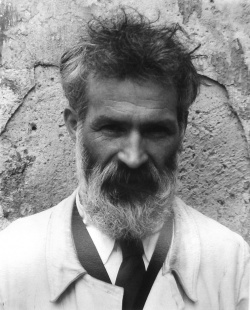Difference between revisions of "Constantin Brâncuşi"
Jump to navigation
Jump to search
Sorindanut (talk | contribs) |
|||
| Line 1: | Line 1: | ||
{{Infobox artist | {{Infobox artist | ||
|image = Edward_Steichen_-_Brancusi.jpg | |image = Edward_Steichen_-_Brancusi.jpg | ||
| − | |imagesize = | + | |imagesize = 250px |
| − | |caption = | + | |caption = Brâncuși in 1922. Photo by Edward Steichen. |
|birth_date = {{birth date|1876|2|19|mf=y}} | |birth_date = {{birth date|1876|2|19|mf=y}} | ||
|birth_place = Hobiţa, Gorj | |birth_place = Hobiţa, Gorj | ||
| − | | | + | |death_date = {{Death date and age|1957|3|16|1876|2|19|mf=y}} |
| + | |death_place = Paris, France | ||
}} | }} | ||
| − | '''Constantin Brâncuşi''' was a Romanian-born sculptor who made his career in France. | + | '''Constantin Brâncuşi''' was a Romanian-born sculptor who made his career in France. His most well-known works include the ''Sleeping Muse'' (1908), ''The Kiss'' (1908), ''Prometheus'' (1911), ''Mademoiselle Pogany'' (1913), ''The Newborn'' (1915), ''Bird in Space'' (1919) and ''The Column of the Infinite (Coloana infinitului)'', also known as ''The Endless Column'' (1938). Considered the pioneer of modernism, Brâncuși is called the patriarch of modern sculpture. |
| − | |||
==Legacy== | ==Legacy== | ||
| − | He | + | He left behind around 1200 photographs and 215 sculptures. |
| − | == | + | ==External links== |
| − | *[http://en.wikipedia.org/wiki/Brancusi Brâncuşi on Wikipedia] | + | * [http://en.wikipedia.org/wiki/Brancusi Brâncuşi on Wikipedia] |
| − | *[http://ro.wikipedia.org/wiki/Constantin_Br%C3%A2ncu%C8%99i Brâncuşi on | + | * [http://ro.wikipedia.org/wiki/Constantin_Br%C3%A2ncu%C8%99i Brâncuşi on Romanian Wikipedia] |
| − | *[http://www.guggenheim.org/new-york/collections/collection-online/artists/698 Brâncuşi | + | * [http://www.guggenheim.org/new-york/collections/collection-online/artists/698 Brâncuşi in the Guggenheim Museum] |
Revision as of 02:01, 30 October 2013
 Brâncuși in 1922. Photo by Edward Steichen. | |
| Born |
February 19, 1876 Hobiţa, Gorj |
|---|---|
| Died |
March 16, 1957 (aged 81) Paris, France |
Constantin Brâncuşi was a Romanian-born sculptor who made his career in France. His most well-known works include the Sleeping Muse (1908), The Kiss (1908), Prometheus (1911), Mademoiselle Pogany (1913), The Newborn (1915), Bird in Space (1919) and The Column of the Infinite (Coloana infinitului), also known as The Endless Column (1938). Considered the pioneer of modernism, Brâncuși is called the patriarch of modern sculpture.
Legacy
He left behind around 1200 photographs and 215 sculptures.